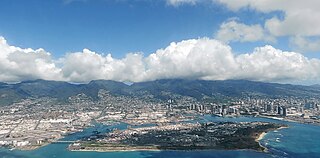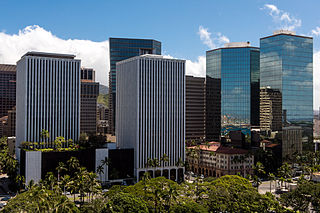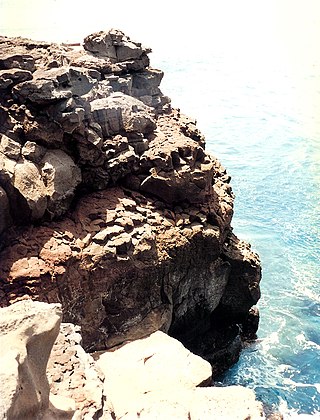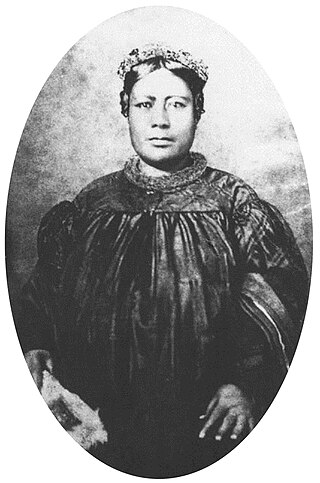
Honolulu is the capital and most populous city of the U.S. state of Hawaii, which is in the Pacific Ocean. An unincorporated city, it is the county seat of the consolidated City and County of Honolulu, situated along the southeast coast of the island of Oʻahu, and is the westernmost and southernmost major U.S. city. Honolulu is Hawaii's main gateway to the world. It is also a major hub for business, finance, hospitality, and military defense in both the state and Oceania. The city is characterized by a mix of various Asian, Western, and Pacific cultures, reflected in its diverse demography, cuisine, and traditions.

The Aloha Tower is a retired lighthouse that is considered one of the landmarks of the state of Hawaii in the United States. Opened on September 11, 1926, at a then astronomical cost of $160,000, the Aloha Tower is located at Pier 9 of Honolulu Harbor. It has been, and continues to be, a guiding beacon welcoming vessels to the City and County of Honolulu. Just as the Statue of Liberty greeted hundreds of thousands of immigrants each year to New York City, the Aloha Tower greeted hundreds of thousands of immigrants to Honolulu. At 10 stories and 184 feet (56 m) of height topped with 40 feet (12 m) of flag mast, for four decades the Aloha Tower was the tallest structure in Hawaii. It was built in the Hawaiian Gothic architectural style.

Bernice Pauahi Pākī Bishop KGCOK RoK was an aliʻi (noble) of the Royal Family of the Kingdom of Hawaii and a well known philanthropist. At her death, her estate was the largest private landownership in the Hawaiian Islands, comprising approximately 9% of Hawaii's total area. The revenues from these lands are used to operate the Kamehameha Schools, which were established in 1887 according to Pauahi's will. Pauahi was married to businessman and philanthropist Charles Reed Bishop.

Kamehameha Schools, formerly called Kamehameha Schools Bishop Estate (KSBE), is a private school system in Hawaiʻi established by the Bernice Pauahi Bishop Estate, under the terms of the will of Princess Bernice Pauahi Bishop, who was a formal member of the House of Kamehameha. Bishop's will established a trust called the "Bernice Pauahi Bishop Estate" that is Hawaiʻi's largest private landowner. Originally established in 1887 as an all-boys school for native Hawaiian children, it shared its grounds with the Bishop Museum. After it moved to another location, the museum took over two school halls. Kamehameha Schools opened its girls' school in 1894. It became coeducational in 1965. The 600-acre (2.4 km2) Kapālama campus opened in 1931, while the Maui and Hawaiʻi campuses opened in 1996 and 2001, respectively.

The Bernice Pauahi Bishop Museum, designated the Hawaiʻi State Museum of Natural and Cultural History, is a museum of history and science in the historic Kalihi district of Honolulu on the Hawaiian island of Oʻahu. Founded in 1889, it is the largest museum in Hawaiʻi and has the world's largest collection of Polynesian cultural artifacts and natural history specimens. Besides the comprehensive exhibits of Hawaiian cultural material, the museum's total holding of natural history specimens exceeds 24 million, of which the entomological collection alone represents more than 13.5 million specimens. The Index Herbariorum code assigned to Herbarium Pacificum of this museum is BISH and this abbreviation is used when citing housed herbarium specimens.

Charles Reed Bishop was an American businessman, politician, and philanthropist in Hawaii. Born in Glens Falls, New York, he sailed to Hawaii in 1846 at the age of 24, and made his home there, marrying into the royal family of the kingdom. He served several monarchs in appointed positions in the kingdom, before its overthrow in 1893 by Americans from the United States and organization as the Territory of Hawaii.

Honolulu Harbor, also called Kulolia and Ke Awa O Kou and the Port of Honolulu, is the principal seaport of Honolulu and the State of Hawaiʻi in the United States. From the harbor, the City & County of Honolulu was developed and urbanized, in an outward fashion, over the course of the modern history of the island of Oahu. It includes Matson, Inc. harbors on Sand Island.
The following is an alphabetical list of articles related to the U.S. state of Hawaii:

Downtown Honolulu is the current historic, economic, and governmental center of Honolulu, the capital and largest city of the U.S. state of Hawaii. It is bounded by Nuʻuanu Stream to the west, Ward Avenue to the east, Vineyard Boulevard to the north, and Honolulu Harbor to the south. Both modern and historic buildings and complexes are located in the area, with many of the latter declared National Historic Landmarks on the National Register of Historic Places.

First Hawaiian Center is the second tallest building in the U.S. state of Hawaiʻi and the city of Honolulu, the largest city in the state. It is the world corporate headquarters of First Hawaiian Bank, the oldest and largest bank based in Hawaiʻi. The tower is one of the most well-known buildings in Honolulu, with a striking presence at the center of downtown Honolulu's skyline.

Ruth Ke‘elikōlani, or sometimes written as Luka Ke‘elikōlani, also known as Ruth Ke‘elikōlani Keanolani Kanāhoahoa or Ruth Keanolani Kanāhoahoa Ke‘elikōlani, was a member of the House of Kamehameha who served as Governor of the Island of Hawaiʻi and for a period, was the largest and wealthiest landowner in the Hawaiian islands. Keʻelikōlani's genealogy is controversial. Her mother's identity has never been in question but her grandfather Pauli Kaōleiokū's relationship to Kamehameha I is heavily disputed. While her father has been legally identified as early as 1864, disputes to that lineage continued as late as 1919. As one of the primary heirs to the Kamehameha family, Ruth became landholder of much of what would become the Bernice Pauahi Bishop Estate, funding the Kamehameha Schools.

Keōua Hale was the mansion of Princess Ruth Keʻelikōlani at 1302 Queen Emma Street in downtown Honolulu, Hawaii.

Falls of Clyde is the last surviving iron-hulled, four-masted full-rigged ship, and the only remaining sail-driven oil tanker. Designated a U.S. National Historic Landmark in 1989, she is now a museum ship in Honolulu, but her condition has deteriorated. She is currently not open to the public. In September 2008, ownership was transferred to a new nonprofit organization, the Friends of Falls of Clyde. Efforts to raise $1.5 million to get the ship into drydock did not succeed. In November 2021 HDOT accepted a bid from Save Falls of Clyde – International (FOCI) to transport the ship to Scotland for restoration.

The Aloha Tower Marketplace is a waterfront shopping center in Honolulu, Hawaiʻi. Located at the Honolulu Harbor, the Aloha Tower Marketplace includes several national historic landmarks including the Aloha Tower, Falls of Clyde and Hawaiʻi Maritime Center.

Ka Lae, also known as South Point, is the southernmost point of the Big Island of Hawaii and of the 50 United States. The Ka Lae area is registered as a National Historic Landmark District under the name South Point Complex. The area is also known for its strong ocean currents and winds and is the home of a wind farm.

Laura Kanaholo Kōnia was a high chiefess of the Kingdom of Hawaii. She was the mother of Bernice Pauahi Bishop, the founder of Kamehameha Schools.

Honolulu County, officially known as the City and County of Honolulu, is a consolidated city-county in the U.S. state of Hawaii. The city-county includes both Urban Honolulu and the rest of the neighborhoods on the island of Oʻahu, as well as several minor outlying islands, including all of the Northwestern Hawaiian Islands except Midway Atoll.

Lucy Kaopaulu Peabody was a high chiefess and courtier of the Kingdom of Hawaii. She served as a maid of honour and lady-in-waiting to Queen Emma of Hawaii. In 1905, she founded the reestablished Kaʻahumanu Society, a female-led civic society initially chartered during the Hawaiian monarchy.
Charles Montague Cooke Jr. was an American malacologist who published under the name of C. Montague Cooke or C.M. Cooke.

Lahilahi Webb, was the last lady-in-waiting and companion of Queen Liliuokalani from 1914 to 1917 during the final years of the queen's life. She also worked as a guide and cultural ambassador for the Bernice Pauahi Bishop Museum.


















